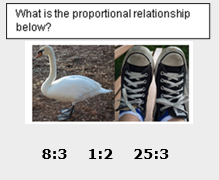Clarifications:
Essential Understandings
Concrete:
- Identify the proportional relationship using visuals.

- Recognize a line on a graph.
- Identify if the line is going up or going down.
- Given 2 points on the line, count the change going up and down between the 2 points.
- Given 2 points on the line, count the change going left and right between the 2 points.
- Recognize the meaning of the placement of numbers in a proportion for a given situation.
- Represent the proportion of objects (female students) to the total number of objects (students in class), part-to-whole.
- Represent the proportion of the number of one object (female students) to the number of other objects (male students) from a set of objects (male and female students), part-to-part.
- Find a percentage of a quantity as a rate per 100 (e.g., 20% of a quantity means 20/100 or .20 times the quantity).
- Understand the following concepts, symbols, and vocabulary: proportion, ratio, rate, prices, portions per person.
| Number: MAFS.7.RP.1.AP.2a | Category: Access Points |
| Date Adopted or Revised: 06/14 |
Cluster:
Analyze proportional relationships and use them to solve real-world and mathematical problems. (Major Cluster) : Clusters should not be sorted from Major to Supporting and then taught in that order. To do so would strip the coherence of the mathematical ideas and miss the opportunity to enhance the major work of the grade with the supporting clusters. |
